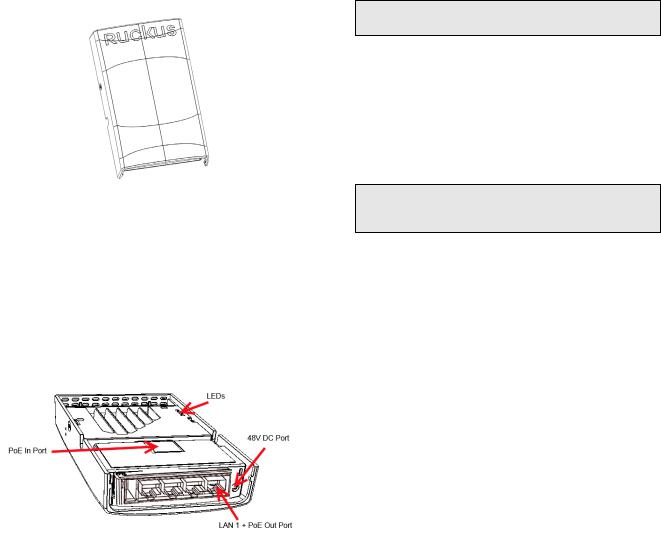Ruckus Wireless H510 Users Manual

H510 Access Point
Quick Setup Guide
This Quick Setup Guide provides step-by-step instructions on how to set up your Ruckus Wireless H510 Dual Band 802.11ac Multimedia Wi-Fi Access Point Wall Switch. After completing the steps described in this guide, you will be able to access the Wi-Fi Wall Switch and begin providing wired and wireless network access to users. The rest of this document refers to the H510 Access Point Wall Switch as the H510.
The H510 has many options:
•It can be mounted on a standard USAor EU-style singlegang wall outlet box.
•It can be powered by a customer-supplied IEEE 802.3afor 802.3at-compliant PoE switch or injector, or can be powered by an optional customer-ordered DC power adapter.
•It has side cutouts for one or two bypass cables. The mounting bracket has locating hooks to keep the bypass cables aligned with the cutouts when attaching the H510 to the mounting base.
•It can have a low-power (0.5W or less) customer-supplied USB device plugged in. The USB device is very difficult to remove after the H510 is attached to the mounting base.
Note: The H510 requires Ruckus Wireless base image 104.0 firmware or later. Managed H510 deployments require SmartZone 3.4 or later, or ZoneFlex (ZF) 9.13.1 or later.
ABOUT PERIPHERAL DEVICES
The H510 can supply power to USB devices and PoE-powered devices, and the power supplied depends on the PoE power supplied to the H510.
•The USB port is intended for low-power devices such as BLE (Bluetooth low energy) beacons. The maximum power that the USB port can supply is 0.5W.
•The LAN1+PoE port is intended for PoE-powered peripheral devices such as IP telephones.
H510 Power Options and Available Power Out for PoE Out and USB
H510 Power Source |
Power Available for PoE Out |
|
and USB |
|
|
802.3af PoE |
5W total |
|
|
802.3at PoE |
12.95W PoE Out (802.3af |
|
Class 3) and |
|
0.5W USB |
|
|
DC power adapter (sold |
12.95W PoE Out (802.3af |
separately) |
Class 3) and |
|
0.5W USB |
|
|
THIS GUIDE IN OTHER LANGUAGES
• https://support.ruckuswireless.com
•Vous trouverez la version française de ce guide à l'adresse suivante https://support.ruckuswireless.com
•https://support.ruckuswireless.com
(https://support.ruckuswireless.com)
•Veja a versão em português (Brasil) deste guia em https://support.ruckuswireless.com
•Puede ver la versión en español (América Latina) de esta guía en https://support.ruckuswireless.com
BEFORE YOU BEGIN
Before deploying Ruckus Wireless products, please check for the latest software and the release documentation.
•User Guides and Release Notes are available at http://support.ruckuswireless.com/documents
•Software Upgrades are available at http://support.ruckuswireless.com/software
•Open Source information is available at http://opensource.ruckuswireless.com
•Software License and Limited Warranty are available at http://support.ruckuswireless.com/warranty
PACKAGE CONTENTS
•H510 Access Point Wall Switch
•Mounting bracket
•Two 6mm M3x0.5 thread Torx flat head machine screws
•Two 1” 6-32 thread Phillips pan head machine screws
•Product warranty statement
•Regulatory flyer
•Declaration of Conformity, if required
•This Quick Setup Guide
Copyright © 2016 Ruckus Wireless, Inc. |
Page 1 of 4 |
Published April 2016, Part Number 800-71206-001 Rev A |
|

STEP 1: COLLECTING TOOLS AND SETUP
REQUIREMENTS
•No. 2 Phillips screwdriver and T10 Torx driver for the mounting bracket screws
•A standard USAor EU-style single-gang wall outlet box
•One of the following:
•Customer-supplied IEEE 802.3af/at-compliant PoE switch and customer-supplied Ethernet cable
•Customer-supplied IEEE 802.3af/at-compliant PoE injector and customer-supplied Ethernet cable
•Customer-ordered DC power adapter (Ruckus part number 902-0170-XX10, sold separately)
•An Ethernet cable with or without PoE run through the wall from your LAN through the wall outlet box
•A computer with an Ethernet port and a wireless card with customer-supplied Cat 5e or better Ethernet cable
•(optional) One or two separate bypass cables run through the outlet box
STEP 2: CONNECTING THE COMPUTER TO THE
H510
Figure 1: Front view
1After removing your H510 from its package, place it next to your computer.
2Using an Ethernet cable, connect your computer’s network port to the PoE In port on the rear of the H510.
3Using an AC adapter (sold separately), connect the H510 48VDC port to a protected power source.
Alternatively, connect the PoE In port to a PoE injector or PoE switch for both power and network connections.
4Verify that the PWR LED on the rear of the enclosure is a steady green.
Figure 2: Rear and bottom view
STEP 3: PREPARING YOUR COMPUTER FOR H510
SETUP
Note: The following procedures assume that Windows 7 is the operating system. Procedures for other OS’s are similar.
1On your Windows 7 computer, configure your network adapter from the Local Area Connection settings as follows:
•Start > Control Panel > Network and Sharing Center > Change Adapter Settings
2Edit the TCP/IPv4 address settings as follows:
•Local Area Connection > Properties > Internet Protocol Version 4 (TCP/IPv4) > Properties
The Internet Protocol Version 4 (TCP/IPv4) Properties dialog box appears.
Important! Write down all of the currently active settings so you can restore your computer to its current configuration later, when this process is complete.
3Select Use the following IP address (if it is not already selected) and then make the following entries:
•IP address: 192.168.0.22 (or any available address in the 192.168.0.x network, except 192.168.0.1)
•Subnet mask: 255.255.255.0
•Default gateway: 192.168.0.1
Leave the DNS server fields empty.
4 Click OK to save your changes.
Your changes are put into effect immediately.
Copyright © 2016 Ruckus Wireless, Inc. |
Page 2 of 4 |
Published April 2016, Part Number 800-71206-001 Rev A |
|
